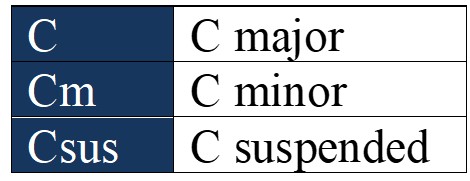A chord is the union of three or more notes played simultaneously. There are countless possible combinations to be made with notes, resulting in the most diverse chords. So, to make life easier for musicians, each chord is given a name.
This name is based on the fundamental notes we know (do, re, mi, fa, sol, la, ti).
Definition of natural chords
Before learning how to name chords, it is important to know that some chords are given the same name as the notes (do, re, mi, fa, sol, la, ti). These are called natural chords. Each of these chords consists of three notes. Moreover, there is a rule to find out what those three notes are.
The notes that form the natural chords are the first, the third and the fifth degrees of their respective scales. Later on, we will apply this rule in practice, to facilitate visualization.
Before that, it is worth knowing that a chord can be major, minor or suspended. These nomenclatures are related to the third degree.
To form the major chords, you use the major third degree. To form the minor chords, you use the minor third degree. When the chord does not have the third degree, it cannot be classified as major or minor, receiving the denomination “suspended“.
The symbols used are as follows: “m” to say that the chord is minor and “sus” to say that the chord is suspended. When none of these symbols exist, it means that the chord is major. See the examples below, using the C chord:
The fifth degree, in all these cases, is the perfect fifth.
What are triads?
Very well, when we talk about the three notes that form the natural chords, we are talking about the triad of each chord. This name exists to represent the chord forming notes. The definition of a triad then is the following: three notes that form chords (1st, 3rd and 5th degrees).
Well, now that we’ve learned the rules, let’s form chords using these concepts. Think of a chord that you want to form. For example, C major.
- First degree: C
- Major third degree: E
- Fifth degree (perfect fifth): G
Therefore, the C major chord is formed by the notes C, E and G. All you have to do is press (or let sound) these notes on your instrument and you will have the C major chord. Now let’s form the F minor chord:
- First degree: F
- Minor third degree: A flat
- Perfect fifth: C
Therefore, the F minor chord is formed by the notes F, A flat and C.
What are tetrads?
So far, we’ve only seen chords formed with 3 notes. By expanding the concept a bit, we can work with 4 notes instead of just 3, and we do this by adding the seventh degree to our previous chords. Thus, we form the seventh chords. The set of degrees first, third, fifth and seventh consist of a tetrad. The seventh degree can be major or minor.
Okay, so from now on when you hear someone say “play the tetrad of chord xxx“, you will already know that it is the first, third, fifth and seventh degrees of the chord in question.
These are the main notes of the chord, known as chord notes (or chord tones). In the studies below, you will understand that these are the notes that characterize a harmonic function.
For now, it is enough to know only that these notes are the backbone of the chord. They define whom we are talking about, they are the ones who guide us.
Go to: Music Intervals – another view
Back to: Module 2

